This Shepherds Bread is made with simple ingredients and baked in a conventional oven using a bread pot, Dutch oven, or bread cloche.
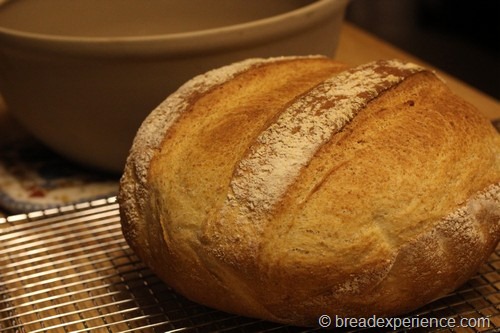
There’s something very comforting about a simple loaf of bread made with simple ingredients. This Shepherd’s Bread is one of those simple breads that’s a pleasure to make and soothing to eat. It reminds me of simpler times.
Karen of Bake My Day is hosting the Bread Baking Babes (BBB) and Friends this month and she chose this comfy bread for the monthly bake.
Shepherd’s Bread is similar to Basque Bread, which originated in the Basque region of Spain. The Basque sheepherders traditionally bake this bread in a cast-iron Dutch oven in a pit in the ground.
I think this would be a great bread to take camping and bake in a cast iron Dutch oven over a fire.
However, if you prefer a more conventional method, shepherd’s Bread can also be baked above ground in the comfort of your own home.
There are several options for baking this loaf in your home oven. You can bake it in a clay baker, (La Cloche, Bread Dome, or other), a cast iron Dutch oven, or even freeform on a baking stone.
Although I have a cast iron Dutch oven, I opted to make this bread in my Bread Dome. I was pleased with the results.
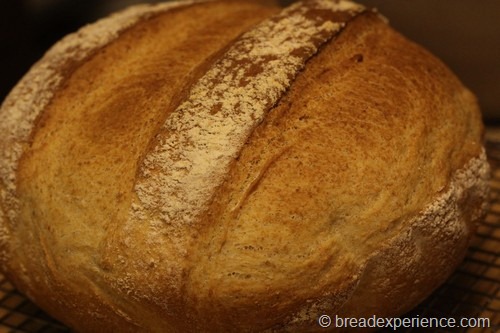
This is a very versatile recipe. Karen of Bake My Day made an all-white flour version, one with a white flour and rye sponge and another version with amaranth and white flour in the sponge and the final dough.
You can substitute the flours, just bear in mind the ratios of half whole wheat (or rye or other grain) and half white bread flour for the sponge and about 25% to 30% whole wheat/other grain to bread flour in the final dough.
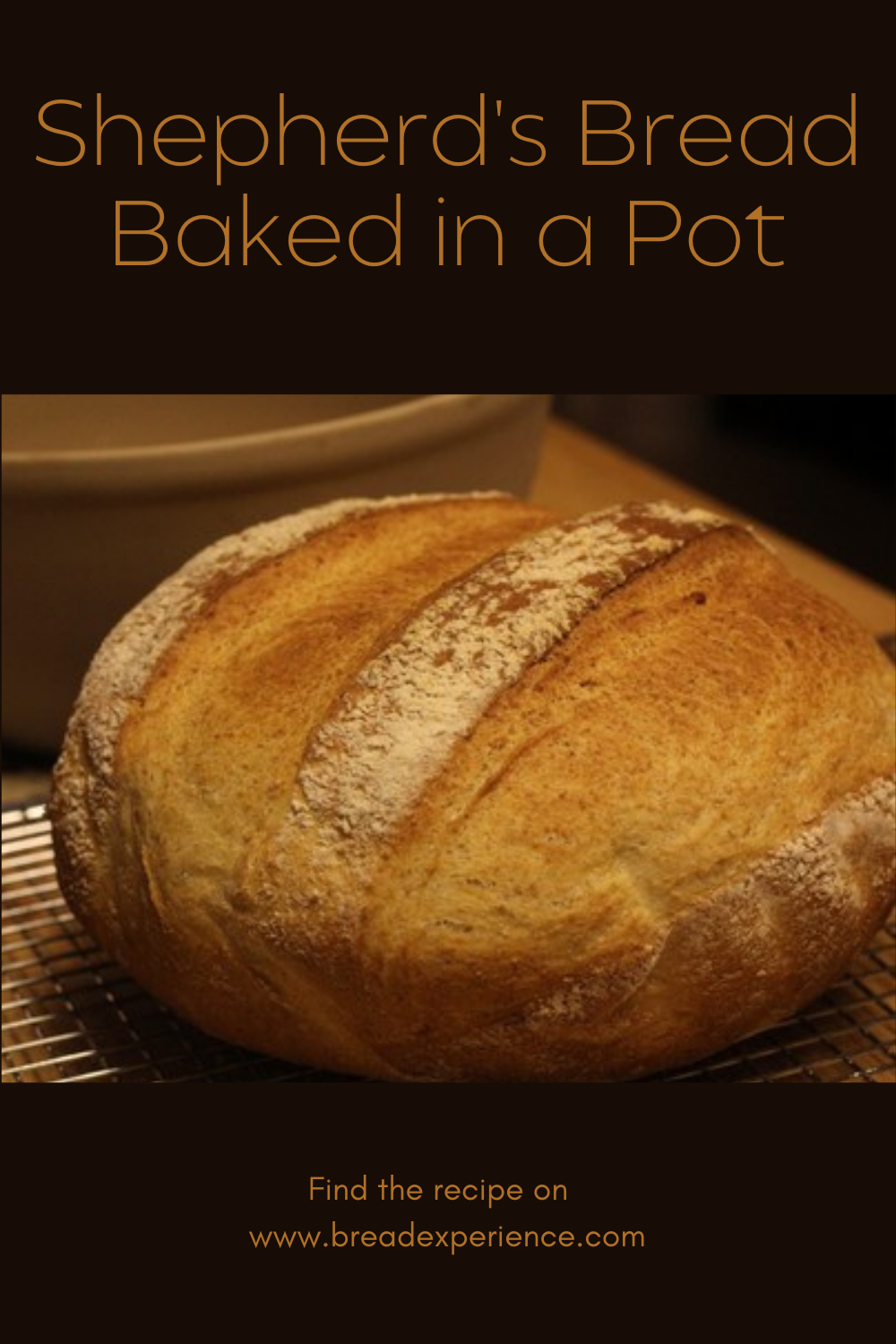
Shepherds Bread Baked in a Pot
Makes: One 2-pound loaf
Adapted from: Bread for all Seasons by Beth Hensperger
The original recipe made a huge loaf so I cut the recipe in half and reduced the amount of sugar. I substituted white whole wheat for some of the bread flour in the dough, but not the sponge. For the dough, my ratio of white whole wheat to bread flour was about 31%, but overall I only used about 24% white whole wheat.
Ingredients:
Sponge (takes about 2 hours)
- 1 tsp. active dry yeast
- 1 cup warm water
- 1 cup unbleached all-purpose or bread flour
- 1/8 cup sugar (you can use a little more sugar if you want a sweeter bread)
Dough (first rise about 2-3 hours; second only 15 minutes)
- 1/2 tsp. active dry yeast
- 1/2 cup warm water
- 1 1/2 tsp. salt
- 1/4 cup olive oil
- 1 cup white whole wheat flour (I used home-milled flour)
- 2 cups unbleached bread flour
- 1/4 cup extra bread flour for kneading
Directions:
1) Prepare the sponge
In a large bowl sprinkle the dry yeast over the warm water, Using a large whisk add 1/2 cup of the flour and the sugar. Add remaining 1/2 cup of flour and beat hard until very smooth, 2 minutes.
Scrape down the sides of the bowl and cover with plastic wrap. Let stand at room temp until soft, spongy, and pleasantly fermented, about 2 hours.
2) Prepare the dough
Using a wooden spoon, beat down the sponge. In a measuring cup or small bowl, stir the yeast into the warm water to dissolve. Add the yeast, warm water, salt, and olive oil to the sponge and beat well. Add the flour, 1/2 cup at a time, beating vigorously until a soft dough is formed that just clears the sides of the bowl.
3) Knead the Dough
Turn out the dough onto a floured work surface and knead for about 5 minutes until a smooth dough is formed. It should be firm yet springy and resilient. Only add about 1 tbs flour at a time to prevent sticking. My dough was a little sticky but I didn’t add more flour at this point. Home-milled flour usually soaks up more water so I decided to wait until after the bulk fermentation to add any additional flour.
Place the dough in a floured (or oiled) deep container, dust the top with flour, and cover with plastic wrap. Let rise at cool room temp until tripled in bulk, 2.5 – 3 hours.
4) Shaping
Turn out the dough onto a clean surface. It will be slightly sticky from the long rise. Knead in about 1/4 cup more flour to make a firmer dough, about 1 minute. Shape into a tight round ball. Pull the ends tightly to the center of the loaf to form a smooth bottom and sides. Mist the surface with water. Coat the top surface with flour. Placing the dough on parchment paper makes it easier to remove the bread from the pot.
5) Score the loaf / Final proof
Using a serrated knife or lame, slash the top of the loaf, no more than 1/4 inch deep to allow steam to escape and allow room for the dough to expand.
I used a lame because the serrated knife was a bit too big to maneuver when the bread was in the pot. In hindsight, I should’ve made the slashes before I placed the dough in the pot especially since it was already on the parchment paper. This was an experiment so no harm done except I made the slashes a bit too deep.
Place the lid on the bread dome (or Dutch oven or clay baker) and let the dough proof for 15 to 30 minutes.
6) Bake the loaf
Preheat the oven to 425 degrees F. Remove the lid. Spritz the loaf with water and place the lid back on.
Bake the loaf for 10 minutes, then lower the thermostat to 400 degrees F and bake an additional 25-35 minutes. Remove the lid after 30 minutes to allow the loaf to brown thoroughly.
Remove the loaf from the pot and let it cool thoroughly before slicing and serving.
If you prefer to use a baking stone or tiles instead of a baking pot, refer to Karen’s post for some helpful tips.
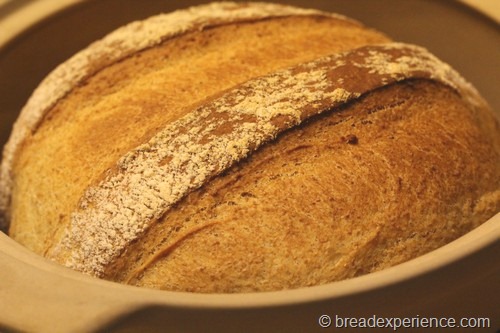
This is a great bread and butter bread. Supposedly, it’s best to eat it on the same day you bake it, but I didn’t try it until the next day and it was great.
The crust was crispy after it baked but it softened up once it cooled. I enjoyed the texture and flavor of this simple Shepherd’s Bread.
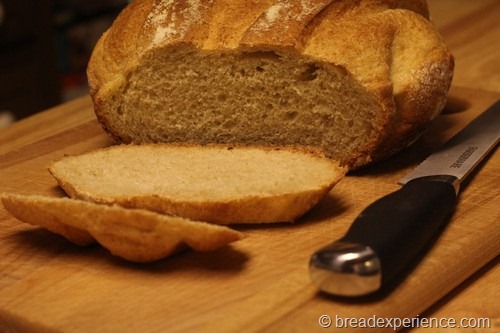
This bread has been YeastSpotted. Please visit Wild Yeast to view all of the lovely breads in the roundup.
You should try this bread… It’s really good! Thanks to Karen for choosing this bread!
Happy Baking!
Cathy
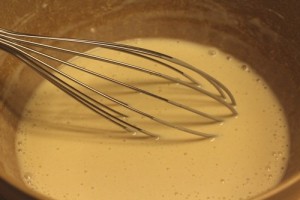

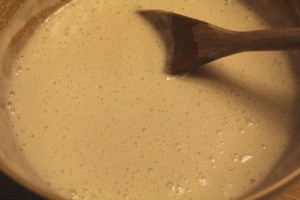
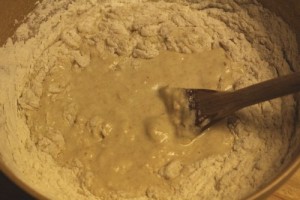
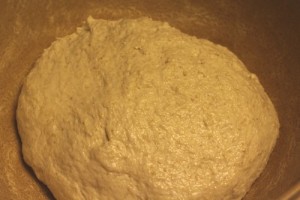
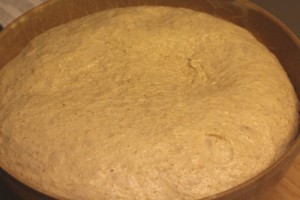
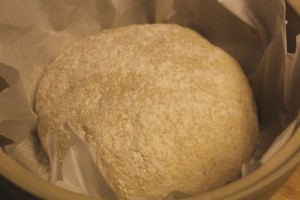
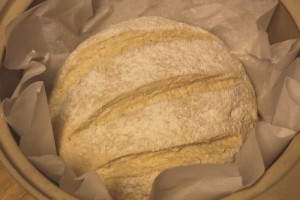
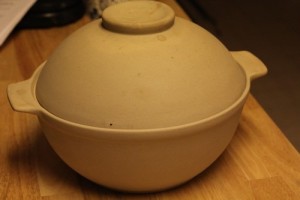
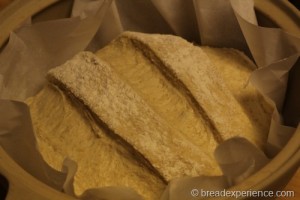
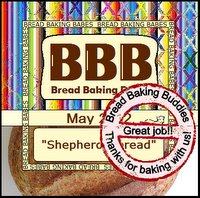
Anonymous says
Thanks for this recipe.
In your “sponge directions,” after whisking 1 cup of flour and the sugar, it reads “add remaining cup of flour.” There’s only 1 cup of flour in the sponge. Please clarify. Thanks!
Cathy (breadexperience) says
Hello, It should read 1/2 cup flour and then add the remaining 1/2 cup flour. Thanks! Glad someone is actually reading these posts. 🙂
Elizabeth says
Your bread looks great, Cathy. And so does that Dutch oven.
I really like how your slashes retained some of their indentation. Beautiful bread. Thank you for baking with us!
Sweet and That's it says
It looks absolutely delicious and cute! And your Dutch oven: to dream of!
How lucky you are: mine has already disappeared and the taste of it is a fading memory 🙂 Think is time to bake another one (two!).
Baking Soda says
Wow Cathy! Looks absoultely fabulous. Love the shape and color of your clay baker! Thanks for baking with us!
Cathy (breadexperience) says
Thanks Ladies! This bread is delicious! Always a pleasure to bake with the BBBs!
sandra says
I have discovered that a sort of fabric non stitch cookie tray liner is more flexible than parchment in my romertopf. Your recipe looks great. Looking forward to trying it. Sandra. Wales
sandra says
Sorry none stick not non stitch!
Mary says
Could this bread dough be split before baking to make smaller loaves for soup bowls?
Cathy says
Hi Mary,
After the bulk proof in the bowl, you could divide the dough into smaller portions and shape into boules (for bowls). Then let the boules rise on a baking sheet lined with parchment paper.
I have a post on making bread bowls with Italian bread dough that might interest you as well
https://www.breadexperience.com/making-bread-bowls/
Happy Baking!
Cathy